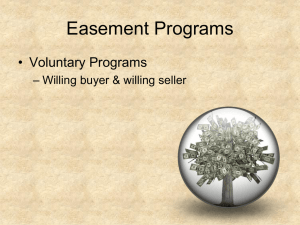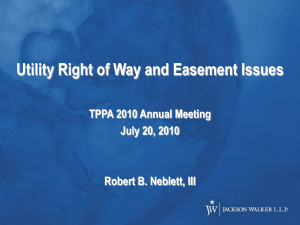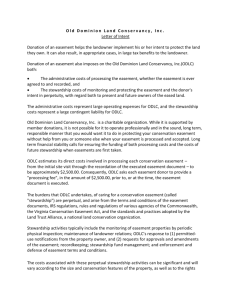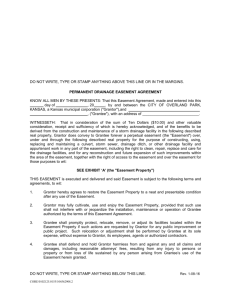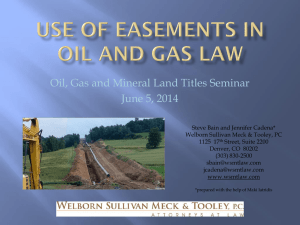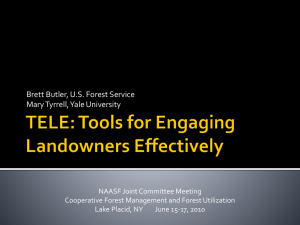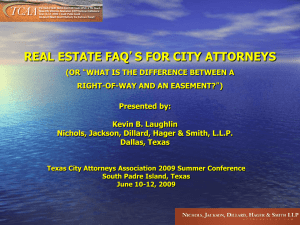Conservation Easements in Wyoming – An Overview
advertisement
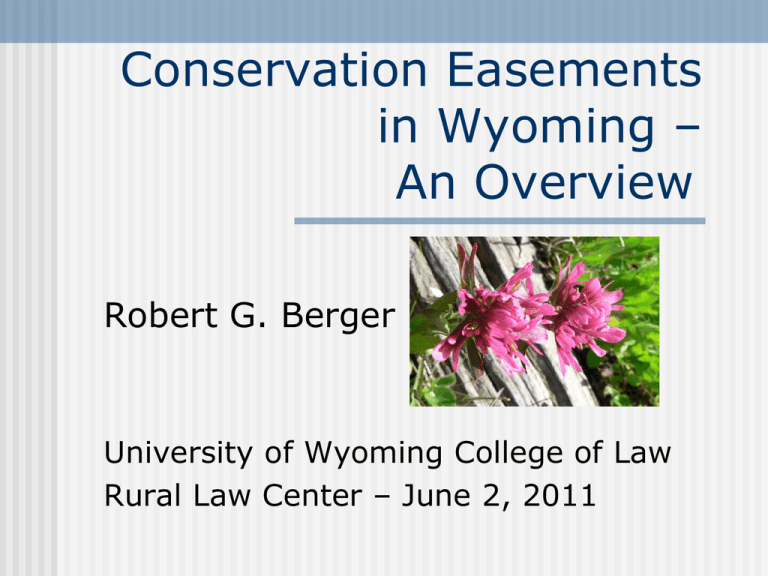
Conservation Easements in Wyoming – An Overview Robert G. Berger University of Wyoming College of Law Rural Law Center – June 2, 2011 Definition “Conservation easements are voluntary agreements that protect resources by limiting development of the land.” Alternative Explanation “Simply put, a conservation easement is a recorded restriction on what you and any future landowner can do with your land. A conservation easement is an agreement… It spells out what activities are prohibited on the property in the future and what activities are permitted on the property in the future. The easement is enforceable against you and any future owner of your land.” Wyoming Law “‘Conservation easement’ means a nonpossessory interest of a holder in real property imposing limitations or affirmative obligations the purposes of which include retaining or protecting natural, scenic, or open-space values of real property, assuring its availability for agricultural, forest, recreational, or open-space use, protecting natural resources, maintaining or enhancing air or water quality, or preserving the historical, architectural, archeological or cultural aspects of real property.” Conservation Easement Created in a contract or deed Landowner gives up rights Easement holder has rights to enforce Protects conservation values Prohibits most commercial/industrial uses Retain rights to agricultural, residential uses Uniform Conservation Easement Act Adopted in 2005 Previously adopted in most states Allows easements “in gross” Easement may be created, modified Interest in minerals not impaired Wyoming Case Law Restrictions construed in favor of the free use of the land An easement entitles the easement holder to a limited use Holder of a negative easement can insist that the burdened party refrain from certain uses Negative easement does affect the title… it has increasing importance in modernday society Perpetuity Easement deemed perpetual Easement must be perpetual for federal tax deduction Certain interests that vest in the future are void Conservation easements vest immediately and do not violate the “Rule Against Perpetuities” Easement Holders Governmental body - not Wyoming board of land commissioners Charitable entity with specified purposes Charitable Corporation Primary purpose must include: • Protecting open space values • Assuring agricultural, forest, recreational or open space use • Protecting natural resources • Maintaining air or water quality • Preserving historical, cultural aspects Easement Holders in Wyoming The Nature Conservancy Wyoming Stock Growers Agricultural Land Trust Wyoming Land Trust Jackson Hole Land Trust Sheridan Community Land Trust Rocky Mountain Elk Foundation Wyoming Game and Fish Commission Landowner Benefits Land Preservation • Seeing the land preserved • Maintaining open spaces • Preventing future owners from changing the character • Protecting scenic views, historical areas or wildlife habitat Income Tax Deduction Must (1) (2) (3) have: Qualified real property interest Qualified organization Conservation purpose Must be perpetual Income Tax Savings Deduct up to 50% of adjusted gross income Based on charitable donation rules Special provisions in 2011 100% for farmers / ranchers in 2011 5 year carryover (15 years in 2011) Based on appraised value before and after easement Estate Tax Savings Lower appraised value Additional estate tax savings under the American Farm and Ranch Protection Act Deduction of up to 40% of the remaining land value (after the easement value is deducted $500,000 limitation Cash Payments Land trusts may buy conservation easement Sale proceeds justify restrictions More available in recent years Farm and Ranch Protection Program; Wyoming Wildlife and Natural Resources Trust fund Monitoring & Enforcement Land trust agrees to monitor and enforce Stewardship donation requested Expect annual monitoring visits Enforcement letters sent Litigation – rare but possible Case Law Lamb v. Wyoming Game and Fish Comm’n Holder of the easement has right to prohibit structures and objects within the easement boundary Salzburg v. Dowd Individual citizen has no standing - Hicks v. Dowd Case settled (2010) – easement remains in effect Case Law Continued Desert Foothills Land Trust, Inc. v. Olsen Land trust had standing to contest road construction Granara v. Stetson Kindred of America, Inc. Neighbors objected to moving historic house onto land protected by conservation easement Held: neighbors have no standing Case Law Continued Zagrans v. Elek Neighbors challenged an easement amendment that substituted additional land Held: neighbors have no standing Gresczyk v. Landis Golf course is not an agricultural operation Case Law Continued Weston Forest & Trail Ass’n. v. Fishman Easement prohibited construction Barn to be removed Duffy v. Milder Easement permitted only grazing, not additional equestrian uses Case Law Continued United States v. Blackman Renovating historic house without approval Easement enforceable Ephrata Area School District v. County of Lancaster Road right-of-way would not interfere with conservation easement Case Law Continued Fenster v. Tiburon Town Council Library use is a recreational use Stitzel v. State of Maryland Conservation easement prohibited any subdivision; landowners then sold a small parcel Held: the sale of the separate parcel is void Case Law Continued Parker v. Grand River Partners, Inc. Held: barn is not permitted outside of building envelope Turner v. Comm’r Conservation easement limited development to 30 residential lots Did not meet the open space conservation purpose test Conclusion Useful tool for preserving open space More are recorded every year Easements will be enforced Important part of Wyoming property law and land use This presentation is not prepared for the purpose of giving legal advice and does not constitute legal advice. It includes legal references, concepts and ideas, intended to provide a general overview of the topic and to assist with discussion of the topic. It may not be relied upon as legal advice by any person. All persons should rely on the advice of their individual attorneys and other personal advisors in implementing any legal plan.

